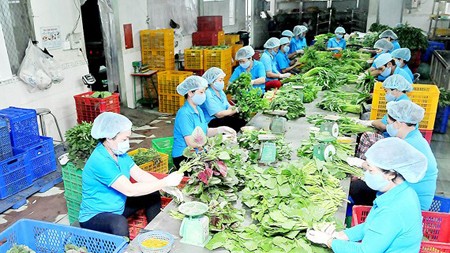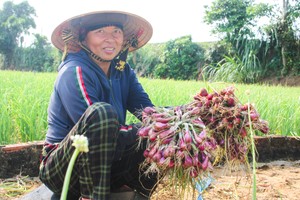
The trend of collaboration
At the moment, there are 61 cooperatives and 236 collaborative teams in HCMC, along with Hung Dien Import-Export-Organic Agricultural Cooperative Union, which is located in Binh Tan District and has 4 members of Duyen Hai, Truong Thinh, Dien Phat, as well as Green Organic Aquaculture.
This year, there are 8 new agriculture cooperatives, increasing the total amount of arable farm to 646ha, with the average of 13.5ha per cooperative. Among them, the leader as to surface area for cultivation is Tho Viet Cooperative with 108ha to grow organic vegetables, while the least is Ngoc Diem Cooperative with 0.85ha to grow ornamental plants. 26 out of 61 cooperatives in HCMC successfully follow the policy to produce and sell agricultural goods like organic vegetables, ornamental plants, cattle, aquaculture produce, and girdle-cakes.
Reports of the HCMC Department of Agriculture and Rural Development show that the connections among cooperatives or between cooperatives and businesses have witnessed a promising increase, especially concerning organic vegetables and dairy cows. Tan Thong Hoi Cooperative and Phuoc An Cooperative have entered the list of 100 most prominent cooperatives in Vietnam, selected by the Ministry of Agriculture and Rural Development.
Besides, 8 cooperatives of Phu Hoa Dong (producing girdle-cakes), Tho Viet, Nhuan Duc, Phu Loc, Phuoc Binh, Phuoc An, Nga Ba Giong, and Nam Viet have already signed contracts to sell their goods in renowned supermarkets, 7 of which are participating in the supply chain of organic produce under VietGAP, selling tons of merchandise monthly. These 7 organizations, along with Tien Phong and Long Hoa Cooperatives, also agree to deliver produce for 308 safety-qualified stores which mostly sell VietGAP goods like vegetables, pork, girdle-cakes, mushroom, Pangasius Kunyit.
Lately, because the market has required various kinds of produce, cooperatives have had to work together to successfully meet these demands. For example, Phu Loc Cooperative buy vegetables from Hung Dien and Nhuan Duc to deliver necessary goods to customers.
These organizations also take part in the supply chain for input services as well as the output chain since they can negotiate a stable source of merchandise like fertilizer or plant protection chemicals. Any cooperative successful in doing this usually attract many members. Take Phuoc An Cooperative as an example. It works in 3 stages of the supply chain for organic vegetables, consisting of offering plant protection chemicals and fertilizer for its members, designing and applying a detailed production plan for all members after successfully signing a contract with related businesses for output, and lastly collecting produce to transport to selling spots. A similar situation happens with Tan Thong hoi Cooperative, which is responsible for dairy production.
However, this model is still not widely spread because of certain limits in a loose link between these cooperatives and other suppliers of input services or produce buyers, thus the prices are not truly competitive enough compared to normal prices in the market to attract new members.
The weak inner force
HCMC has issued many advantageous policies and guidelines to support agricultural cooperatives from infrastructure to human resources, or even finance so that these organizations are able to self-renovate.
As a result, several cooperatives take full advantage of them to further develop their own inner force and increase their competitiveness via the transformation from only focusing on production and output finding to offering services for producing goods and for improving the living standards of members. This has helped all those members be more confident in participating in the cooperative model.
Nevertheless, there exists poor management of certain cooperative leaders in various wards or districts as they are still used to waiting for the government’s guidance, not being able to exercise the principle of autonomy. As stated by Mr. Tran Ngoc ho, Deputy Director of the HCMC Department of Agriculture and Rural Development, the proportion of trained human resources is quite low, at 33.5 percent. Cooperatives are usually of small scale yet in a harshly competitive status. Therefore, these cooperatives cannot attract investment from related businesses or active participation of members.
Another difficulty comes from the limit of initial capital to run the organization. With only around VND2.6 billion on average (approx. $111,350), it is quite hard for a cooperative to expand its production capacity. Yet the access to a loan is not easy at all since these cooperatives possess little or no mortgage asset. This leads to trouble in producing sufficient merchandise to meet the demands of businesses.
























